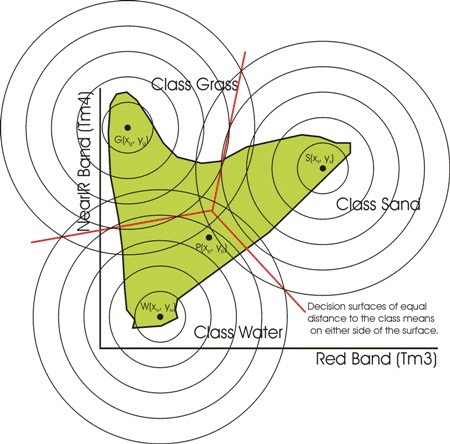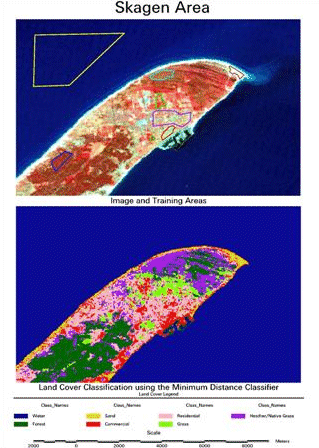Consider for the moment, 2-D data (x,y). With the minimum distance classifier, compute the Euclidean Distance (ED) between the pixel
values (xp,yp) and the mean values for the classes, and then allocate the pixel to that class with the shortest Euclidean distance.
You can also set a maximum distance criterion, so that pixels further than this distance from a class mean, cannot be assigned to that class.
Background Euclidean Distance:
↓↑
We all know what the distance between two points is: It is the shortest out of all possible ways to go from one to the other point.
Euclidean Distance is defined on a Euclidean Vector Space to represent this native definition of distance. If you are not familiar with
Vectorspaces, just remember this native definition and you can follow all the chapter. For all other, please allow us to give a
definition:
Definition of the Distance on a Euklidean Space (which is an affine vektor space with a valid scalar product (dot product) defined on):
On a Euklidean Space we mean with the Distance d(P,Q) of two points P and Q the absolute value of
the vector
PQ→:
dP,Q=PQ→

Three classes, their Euclidean Distances and their Minimum Distance Decision Surfaces

Skagen image, training areas and Minimum Distance Classification
Thus for three classes we would compute three distances:
Then allocate the pixel to the class with the minimum ED, as long as that Euclidean Distance is less than the set
maximum distance threshold.
The Minimum Distance Classifier uses classes that you could consider have zero correlation and
in which all classes had the same variance values. It is thus a special case of the Maximum Likelihood Classifier
that we will meet in the next Chapter.


